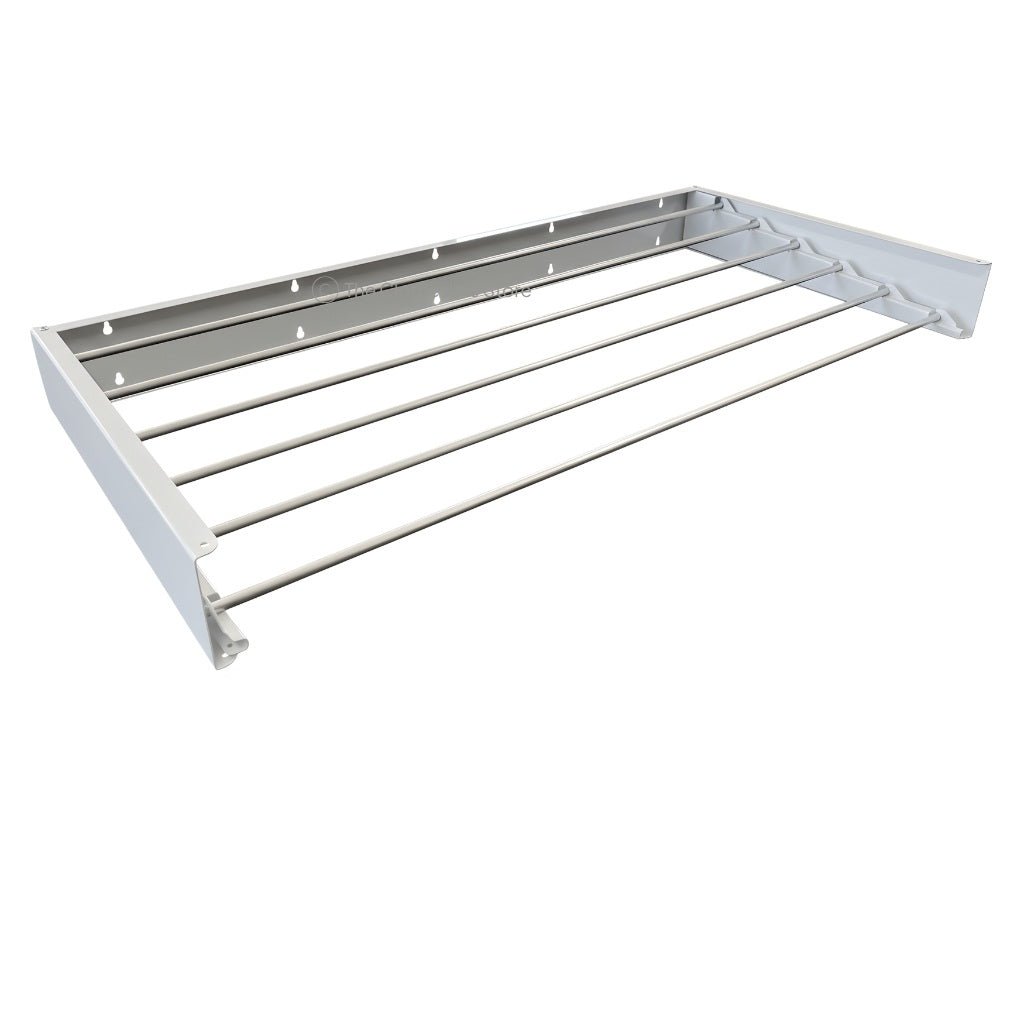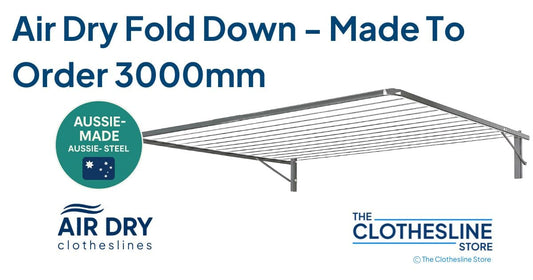
How to Dry Clothes in Winter Without a Tumble Dryer!
Dreaming of a winter where drying clothes does not rely on a clothes dryer? It’s entirely possible! A great fact to know is that the humble tumble dryer can increase carbon emissions by over 3kg per load!*
With that in mind, during the colder winter months, you can use efficient, eco-friendly methods to ensure your wet clothes dry properly. In this guide, we’ll explore how to dry clothes indoors without a tumble dryer, maximise the winter sun, and why opening windows and ensuring good ventilation are crucial for airflow.
These techniques will help you use less energy for drying laundry and save money on your energy bills.

Table of Contents
In this article, we cover effective techniques to dry clothes in winter by:
Harnessing Natural Elements: Utilising sunlight and wind for improved drying efficiency and creating indoor airflow with fans and open windows.
Choosing the Right Equipment: Selecting and using various indoor drying racks and heated air dryers suited to different spaces and needs.
Applying Practical Methods: Employing strategies such as proper drying rack placement, extra spin cycles, and using dehumidifiers to enhance drying speed and prevent moisture issues.
Sunlight Exposure for Winter Drying

No matter the time of year, sunlight helps to dry clothes. In winter, it becomes even more important for drying your garments.
If the weather is not great outside, place your indoor drying rack near a sunny window to let your wet clothes benefit from the sun’s natural warmth and aids to speed up the drying process.
While sunlight is beneficial, airflow is also crucial for speeding up drying. Proper air movement helps carry away excess moisture from your laundry.
Wind Power and Air Circulation

Air movement is key to speeding up clothes drying. Even a light breeze helps. On cold or wet days, open windows for better airflow, though this might not always be feasible.
If you're using your air conditioner for heating, consider using it to dry clothes indoors as well. Place your washing on a portable clothesline to create effective air circulation indoors.
For extra help, use a desk or pedestal fan to boost or create airflow.
Hanging laundry in the bathroom with the extraction fan on, reduces moisture and speeds up drying clothes indoors.
Controlling Humidity with Dehumidifiers

Humidity can significantly impact drying clothes indoors. Using a dehumidifier near your drying rack absorbs moisture from the air inside, speeding up the drying process.
Dehumidifiers also prevent damp smells from wet washing and reduce the risk of mould growth. For optimal results, combine a dehumidifier with an air conditioner or extractor fan to manage indoor humidity levels effectively.
Indoor Clotheslines: What Are Your Options?
Indoor drying racks and clotheslines are a versatile solution for managing washing throughout the year, especially when outdoor drying isn’t feasible in winter. Here’s a detailed look at popular types of indoor drying racks:
Over-the-Door Hanging Racks
These drying racks, such as the styles from Brabantia fit over a door, offering a convenient and space-saving solution.
They are especially useful in small spaces and can be folded away easily when not in use. Great option for overnight clothes and towel drying.
Portable Folding Clotheslines
These versatile clotheslines can be set up in various locations such as the laundry room or living areas.
The foldable design allows for easy storage and portability, making them perfect for homes with limited space.
Many drying racks are high enough to dry towels and hang clothes that are longer, jeans, without them touching the floor permitting you to dry your linen and clothes indoors. These models often hold a full load of laundry!
Retractable Clotheslines
Ideal for garages, covered patios or balconies, these clotheslines extend when needed and retract when not in use.
They provide flexibility and are well-suited for areas where a clothesline is not always installed and carry a full load of laundry.
Compact/Mini Folding Frame Clotheslines
These are designed especially for laundry’s, small spaces and are perfect for apartments or tight areas.
They are multifunctional and can be installed either indoors or outdoors giving you flexibility and they surprisingly hold a good sized load of washing!
When drying your clothes in the laundry or bathroom, use the extraction fan. The speed of the extraction unit assists with removing damp air and you will dry clothes faster with this economical tip.
Wall Mounted Pull Out Clotheslines
The Air Dry Classic clothesline range offers a premium selection of durable, space-saving clotheslines designed for modern living.
The Pull Out range have been engineered for indoor and outdoor use, Willet clotheslines combine functionality with sleek design, making them ideal for homes, apartments, and compact laundry areas.
 Featuring wall-mounted, pull out retractable options the Willet range provides flexible drying solutions that help reduce energy consumption and support eco-friendly lifestyles. Each product is crafted with high-quality materials to withstand harsh weather conditions, ensuring long-lasting performance and value.
Featuring wall-mounted, pull out retractable options the Willet range provides flexible drying solutions that help reduce energy consumption and support eco-friendly lifestyles. Each product is crafted with high-quality materials to withstand harsh weather conditions, ensuring long-lasting performance and value.
 Optimised for small spaces and easy installation, Willet clotheslines are a smart alternative to electric dryers, saving you money while minimising your carbon footprint. Whether you're drying large loads or a few delicate items, the Willet range delivers convenience and reliability.
Optimised for small spaces and easy installation, Willet clotheslines are a smart alternative to electric dryers, saving you money while minimising your carbon footprint. Whether you're drying large loads or a few delicate items, the Willet range delivers convenience and reliability.
 Discover why homeowners are turning to Willet, an Australian owned company, for innovative, space-conscious laundry solutions. Shop the full Air Dry Ready Made Range of Clotheslines today and transform your drying routine.
Discover why homeowners are turning to Willet, an Australian owned company, for innovative, space-conscious laundry solutions. Shop the full Air Dry Ready Made Range of Clotheslines today and transform your drying routine.
Effective Techniques to Dry Clothes Faster Indoors
Using a Clothes Drying Racks
Most small drying racks are designed with heavier items on the top lines and lighter items on the bottom.
Thicker Garments on the Top Rung: Use the top rungs for bulkier items like towels and sweaters. This allows them to hang freely and get better air circulation, speeding up drying.
Smaller Items on the Lower Rung: Hang clothes such as baby clothes, underwear, and smaller items on the lower rungs. This prevents overcrowding on the top and ensures all items get good airflow.
Properly using drying racks helps your clothes dry faster.
Hair Dryer Hack: Because Your Clothes Deserve to Look Fabulous Too!

While not the most energy-efficient method, using a hair dryer can be a quick solution to cut down the drying time for drying smaller garments and reducing excess moisture and dampness.
This technique is particularly useful for essential items like underwear and socks. When using a hair dryer, hold it at arm's length from your clothes to prevent overheating the fabric.
Also, ensure that the airflow to the back of the hair dryer is unobstructed to avoid overheating and potential damage to the appliance.
Hot Iron Dry Clothes
A handy trick for quickly drying a few garments is using a hot iron. This method is ideal for drying one or two pieces in a pinch but is not a long-term solution for drying laundry.
To use this technique, place the freshly washed items on a flat surface, such as an ironing board. Lay a clean dry towel over the clothes and gently run the iron over the towel.
The heat from the iron will help dry the clothes, while the dry towel absorbs excess moisture from the fabric and prevents direct heat damage.
Come in Spinner - Extra Spin Cycle!

Instead of immediately removing your laundry once the cycle finishes, give it an extra spin cycle.
This typically an additional spin cycle takes about 10 minutes and helps remove excess water, speeding up the drying process.
Don't Throw in The Towel
After washing, roll your clothes in a clean, dry towel to absorb additional moisture.
This step reduces drying time and ensures your clothes dry faster, especially when combined with proper airflow.
Open Everything Up

To enhance drying efficiency, make sure to undo zips and buttons, including sleeve cuffs, and pull out trouser pockets.
This allows air to circulate more freely through your garments, helping them dry more evenly and quickly.
Additionally, opening up these areas prevents the formation of damp pockets and creases, leading to a smoother drying process and less ironing later on.
Useful Use for Curtain Rails
Utilise curtain rails as an alternative clothes horse. They offer an ideal spot for hanging fresh laundry with immediate access to airflow from open windows, which speeds up clothes drying times without taking up any of your living room.
Each of these suggestions to dry your clothes indoors will reduce the drying time of your laundry!
Outdoor Drying Clothes in Winter
An old saying goes: If the ground is dry in winter, your clothes will dry outside. There’s some truth to this—dry air and sunshine can still help with drying, even in colder months.
Make the Most of Winter ‘s Sunny Days: Hang your clothes out early in the day to take advantage of the sun before the air gets damp. If the air becomes humid, your washing can start absorbing moisture again.

On a sunny day, water should evaporate from your clothes relatively quickly.
Windy conditions further speed up the drying process, and if it's both sunny and windy, you’ve got ideal drying weather.
Rehang Your Wash: To ensure even drying, re-peg your clothes upside down halfway through the day.
This helps with drying clothes properly as it prevents damp edges or patches where the pegs were.
Utilise Available Sunshine: No matter how cold it is, sunny days help evaporate water from your clothes.
Place your portable clothesline in sunny spots in your garden to make the most of outdoor drying in winter.
Weather Apps: Before choosing to hang your washing inside, let your fingers do the walking and use your favourite weather app.
The information provided will help take the guess work out of a winters day and dry washing!
Managing Laundry Efficiently During Winter

Washing and Drying Less Frequently
Not always a popular choice, consider streamlining your winter laundry routine, cut back on the frequency of washes.
Prioritise washing essentials like socks and underwear, while allowing items such as jeans and jumpers to air out outside (if weather permits) to extend the time between washes.
This strategy conserves water and energy, reduces your laundry load, and helps prolong the life of your garments by minimising wear and tear from excessive washing.
Overnight Drying
Overnight drying is a practical and often under-utilised method for efficiently using high use areas of home when most of us are tucked up in bed.
Set up your indoor drying rack in a well-ventilated room or space, such as the lounge room or hallway, and hang your wet clothes out before you go to bed.
By morning, many items will be completely dry, although thicker items like towels and jeans may need additional time to fully dry.
Conclusion
How to Dry Clothes In Winter without relying on a clothes dryer; this is not only feasible but also a savvy choice for both your wallet and the environment.
By harnessing natural elements like sunlight, wind, and proper airflow, and selecting the right portable airer or clothesline, you can effectively save money on energy costs and keep your laundry fresh.
The strategies outlined in this article offer practical and budget-friendly ways to manage your winter laundry more sustainably.
Free Delivery
At The Clothesline Store, we guarantee the fastest dispatch to ensure the quickest delivery of clotheslines, by operating our own national clothesline warehouse. Don’t take our word for it—check out our Google reviews!
As Australia’s largest private stockholder of clotheslines and accessories, we ship in-stock items the same or next business day. Unlike other retailers who rely on third-party distributors, our dedicated team handles every order directly, ensuring speed and reliability.
With our extensive range of clotheslines stored in our own clothesline warehouse and national centres, we deliver faster and more consistently.
* Australian Government - Your Home - Article Appliances and Technology



























